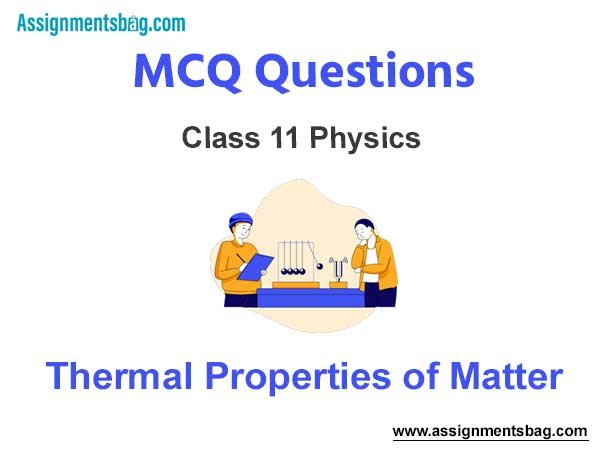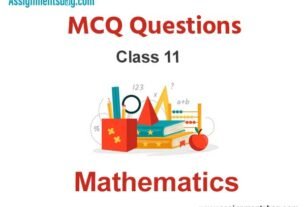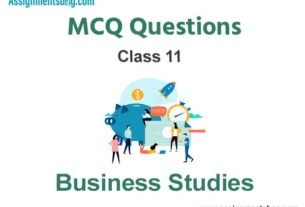Please refer to MCQ Questions Chapter 11 Thermal Properties of Matter Class 11 Physics with answers provided below. These multiple-choice questions have been developed based on the latest NCERT book for class 11 Physics issued for the current academic year. We have provided MCQ Questions for Class 11 Physics for all chapters on our website. Students should learn the objective based questions for Chapter 11 Thermal Properties of Matter in Class 11 Physics provided below to get more marks in exams.
Chapter 11 Thermal Properties of Matter MCQ Questions
Please refer to the following Chapter 11 Thermal Properties of Matter MCQ Questions Class 11 Physics with solutions for all important topics in the chapter.
MCQ Questions Answers for Chapter 11 Thermal Properties of Matter Class 11 Physics
Question. The coefficient of thermal conductivity depends upon
(a) temperature difference between the two surfaces.
(b) area of the plate
(c) material of the plate
(d) All of these
Answer
C
Question. A black body rediates energy at the rate of E watt per metre2 at a high temperature T K. when the temperature is reduced to (T/2) K, the radiant energy will be
(a) E/16
(b) E/4
(c) E/2
(d) 2E
Answer
A
Question. For the construction of a thermometer, one of the essential requirements is a thermometric substance which
(a) remains liquid over the entire range of temperatures to be meaured .
(b) has property that varies linearly with temperature
(c) has a property that varies with temperature
(d) obey Boyle’s law
Answer
C
Question. At a certain temperature for given wave length , the ratio of emissive power of a body to emissive power of black body in same circumstances is known as
(a) relative emissivity
(b) emissivity
(c) absorption coefficient
(d) coefficient of reflection
Answer
C
Question. The resistance of a resistance thermometer has values 2.71 and 3.70 ohms at 10ºC and 100ºC respectively. The temperature at which the resistance is 3.26 ohm is
(a) 40ºC
(b) 50ºC
(c) 60ºC
(d) 70ºC
Answer
C
Question. A cylindrical rod of aluminium is of length 20 cms and radius 2 cms. The two ends are maintained at temperatures of 0ºC and 50ºC the coefficient of thermal conductivity is 0.5 cal/cm×sec ׺C. Then the thermal resistance of the rod in cal/sec ׺C is
(a) 318
(b) 31.8
(c) 3.18
(d) 0.318
Answer
D
Question. The maximum energy in the thermal radiation from a hot source occurs at a wavelength of 11 ×10–5 cm. According to Wien’s law, the temperature of this source (on Kelvin scale) will be n times the temperature of another source (on Kelvin scale) for which the wavelength at maximum energy is 5.5 × 10–5 cm. The value n is
(a) 2
(b) 4
(c) 1/2
(d) 1
Answer
C
Question. Calculate the surface temperature of the planet, if the energy radiated by unit area in unit time is 5.67 ×104 watt.
(a) 1273°C
(b) 1000°C
(c) 727°C
(d) 727K
Answer
C
Question. A crystal has a coefficient of expansion 13×10–7 in one direction and 231 × 10–7 in every direction at right angles to it. Then the cubical coefficient of expansion is
(a) 462 × 10–7
(b) 244 × 10–7
(c) 475 × 10–7
(d) 257 × 10–7
Answer
A
Question. 80 g of water at 30ºC are poured on a large block of ice at 0ºC. The mass of ice that melts is
(a) 1600 g
(b) 30 g
(c) 150 g
(d) 80 g
Answer
B
Question. The thermal capacity of 40g of aluminium (specific heat = 0.2 cal g–1 °C–1) is
(a) 40 cal °C–1
(b) 160 cal °C–1
(c) 200 cal °C–1
(d) 8 cal °C–1
Answer
D
Question. Two marks on a glass rod 10 cm apart are found to increase their distance by 0.08 mm when the rod is heated from 0°C to 100°C. A flask made of the same glass as that of rod measures a volume of 1000 cc at 0°C. The volume it measures at 100°C in cc is
(a) 1002.4
(b) 1004.2
(c) 1006.4
(d) 1008.2
Answer
A
Question. A bimetallic strip is made of aluminium and steel (aAl > asteel). On heating, the strip will
(a) remain straight
(b) get twisted
(c) will bend with aluminium on concave side
(d) will bend with steel on concave side
Answer
D
Question. A uniform metallic rod rotates about its perpendicular bisector with constant angular speed. If it is heated uniformly to raise its temperature slightly
(a) its speed of rotation increases
(b) its speed of rotation decreases
(c) its speed of rotation remains same
(d) its speed increases because its moment of inertia increases
Answer
B
Question. Which of the following temperatures is the highest?
(a) 100K
(b) –13°F
(c) –20°C
(d) –23°C.
Answer
B
Question. Ice starts forming in a lake with water at 0ºC when the atomspheric temperature is –10ºC. If the time taken for the first 1 cm of ice to be formed is 7 hours, then the time taken for the thickness of ice to change from 1 cm to 2 cm is
(a) 7 hours
(b) 14 hours
(c) 21 hours
(d) 3.5 hours
Answer
C
Question. A glass flask of volume 1 litre is fully filled with mercury at 0ºC. Both the flask and mercury are now heated to 100ºC. If the coefficient of volume expansion of mercury is 1.82 × 10–4/ºC, volume coefficient of linear expansion of glass is 10 × 10–6/ºC, the amount of mercury which is spilted out is
(a) 15.2 ml
(b) 17.2 ml
(c) 19.2 ml
(d) 21.2 ml
Answer
A
Question. In a thermocouple, the temperature of the cold junction and the neutral temperature are –40°C and 275°C respectively. If the cold junction temperature is increased by 60°C, the neutral temperature and temperature of inversion respectively become
(a) 275°C, 530°C
(b) 355°C, 530°C
(c) 375°C, 590°C
(d) 355°C, 590°C
Answer
A
Question. The temperature of a furnace is 2324ºC and the intensity is maximum in its radiation spectrum nearly at 12000 Å. If the intensity in the spectrum of a star is maximum nearly at 4800Å, then the surface temperature of the star is
(a) 8400ºC
(b) 7200ºC
(c) 6492.5ºK
(d) 5900ºC
Answer
C
Question. A metal ball of surface area 200 square cm, temperature 527ºC is surrounded by a vessel at 27ºC. If the emissivity of the metal is 0.4, then the rate of loss of heat from the ball is

(a) 108 joule
(b) 168 joule
(c) 182 joule
(d) 192 joule
Answer
C
Question. The temperature of an iron block is 140ºF. Its temperature on the Celsius scale is
(a) 60º
(b) 160º
(c) 140º
(d) 132º
Answer
A
Question. If a liquid is heated in weightlessness, the heat is transmitted through
(a) conduction
(b) convection
(c) radiation
(d) None of these, because the liquid cannot be heated in weightlessness.
Answer
A
Question. The temperature of stars is determined by
(a) Stefan’s law
(b) Wien’s displacement law
(c) Kirchhoff’s law
(d) Ohm’s law
Answer
B
Question. Two straight metallic strips each of thickness t and length l are rivetted together. Their coefficients of linear expansions are a1 and a2 . If they are heated through temperature ΔT, the bimetallic strip will bend to form an arc of radius
(a) t /{α1 + α2) ΔT}
(b) t /{(α2 – α1) ΔT}
(c) t (α1 – α2) ΔT
(d) t (α2 – α1) ΔT
Answer
B
Question. The wavelength of radiation emitted by a body depends upon
(a) the nature of its surface
(b) the area of its surface
(c) the temperature of its surface
(d) All of the above
Answer
D
Question. An aluminium sphere is dipped into water. Which of the following is true?
(a) Buoyancy will be less in water at 0°C than that in water at 4°C
(b) Buoyancy will be more in water at 0°C than that in water at 4°C
(c) Buoyancy in water at 0°C will be same as that in water at 4°C
(d) Buoyancy may be more or less in water at 4°C depending on the radius of the sphere
Answer
A
Question. As the temperature is increased, the period of a pendulum
(a) increases as its effective length increases even though its centre of mass still remains at the centre of the bob
(b) decreases as its effective length increases even though its centre of mass still remains at the centre of the bob
(c) increases as its effective length increases due to shifting to centre of mass below the centre of the bob
(d) decreases as its effective length remains same but the centre of mass shifts above the centre of the bob
Answer
A
Question. Heat is associated with
(a) kinetic energy of random motion of molecules
(b) kinetic energy of orderly motion of molecules
(c) total kinetic energy of random and orderly motion of molecules
(d) kinetic energy of random motion in some cases and kinetic energy of orderly motion in other
Answer
A
Question. The radius of a metal sphere at room temperature T is R and the coefficient of linear expansion of the metal is a. The sphere heated a little by a temperature πΔ so that its new temperature is T + πΔ. The increase in the volume of the sphere is approximately.
(a) 2πRaΔT
(b) πR2aΔT
(c) 4πR3aΔT / 3
(d) 4πR3aΔT
Answer
D
Question. A sphere, a cube and a thin circular plate, all of same material and same mass are initially heated to same high temperature.
(a) Plate will cool fastest and cube the slowest
(b) Sphere will cool fastest and cube the slowest
(c) Plate will cool fastest and sphere the slowest
(d) Cube will cool fastest and plate the slowest
Answer
C
Question. A piece of iron is heated in a flame. It first becomes dull red then becomes reddish yellow and finally turns to white hot. The correct explanation for the above observation is possible by using
(a) Wien’s displacement law
(b) Kirchoff’s law
(c) Newton’s law of cooling
(d) Stefan’s law
Answer
A
Question. The density of water at 20°C is 998 kg/m3 and at 40°C 992 kg/m3. The coefficient of volume expansion of water is
(a) 10–4/°C
(b) 3 × 10–4/°C
(c) 2 × 10–4/°C
(d) 6 × 10–4/°C
Answer
B
Question. Two metal rods 1 and 2 of same lengths have same temperature difference between their ends. Their thermal conductivities are K1 and K2 and cross sectional areas A1 and A2, respectively. If the rate of heat conduction in rod 1 is four times that in rod 2, then
(a) K1A1 = K2A2
(b) K1A1 = 4K2A2
(c) K1A1 = 2K2A2
(d) 4K1A1 = K2A2
Answer
B
Question. Certain quantity of water cools from 70°C to 60°C in the first 5 minutes and to 54°C in the next 5 minutes. The temperature of the surroundings is:
(a) 45°C
(b) 20°C
(c) 42°C
(d) 10°C
Answer
A
Question. Steam at 100°C is passed into 20 g of water at 10°C. When water acquires a temperature of 80°C, the mass of water present will be:
[Take specific heat of water = 1 cal g– 1 °C– 1 and latent heat of steam = 540 cal g– 1]
(a) 24 g
(b) 31.5 g
(c) 42.5 g
(d) 22.5 g
Answer
D
Question. On observing light from three different stars P, Q and R, it was found that intensity of violet colour is maximum in the spectrum of P, the intensity of green colour is maximum in the spectrum of R and the intensity of red colour is maximum in the spectrum of Q. If TP, TQ and TR are the respective absolute temperature of P, Q and R, then it can be concluded from the above observations that
(a) TP > TR > TQ
(b) TP < TR < TQ
(c) TP < TQ < TR
(d) TP > TQ > TR
Answer
A
Question. The two ends of a metal rod are maintained at temperatures 100°C and 110°C. The rate of heat flow in the rod is found to be 4.0 J/s. If the ends are maintained at temperatures 200°C and 210°C, the rate of heat flow will be
(a) 16.8 J/s
(b) 8.0 J/s
(c) 4.0 J/s
(d) 44.0 J/s
Answer
C
Question. The value of coefficient of volume expansion of glycerine is 5 × 10-4 K-1. The fractional change in the density of glycerine for a rise of 40°C in its temperature, is:
(a) 0.020
(b) 0.025
(c) 0.010
(d) 0.015
Answer
A
Question. A piece of ice falls from a height h so that it melts completely. Only one-quarter of the heat produced is absorbed by the ice and all energy of ice gets converted into heat during its fall. The value of h is :
[Latent heat of ice is 3.4 × 105 J/kg and g = 10 N/kg]
(a) 34 km
(b) 544 km
(c) 136 km
(d) 68 km
Answer
C
Question. Coefficient of linear expansion of brass and steel rods are a1 and a2. Lengths of brass and steel rods are l1and l2 respectively. If (l2 – l1) is maintained same at all temperatures, which one of the following relations holds good ?
(a) a1l22 =a2 l12
(b) a1l2 =a2 l1
(c) a1l2 =a2 l1
(d) a1l1 = a2l2
Answer
D
Question. A black body is at a temperature of 5760 K. The energy of radiation emitted by the body at wavelength 250 nm is U1, at wavelength 500 nm is U2 and that at 1000 nm is U3. Wien’s constant, b = 2.88 × 106 nmK. Which of the following is correct ?
(a) U1 = 0
(b) U3 = 0
(c) U1 > U2
(d) U2 > U1
Answer
D
Question. A spherical black body with a radius of 12 cm radiates 450 watt power at 500 K. If the radius were halved and the temperature doubled, the power radiated in watt would be :
(a) 450
(b) 1000
(c) 1800
(d) 225
Answer
C
Question. Two rods A and B of different materials are welded together as shown in figure. Their thermal conductivities are K1 and K2. The thermal conductivity of the composite rod will be :

Answer
D

We hope you liked the above provided MCQ Questions Chapter 11 Thermal Properties of Matter Class 11 Physics with solutions. If you have any questions please ask us in the comments box below.


